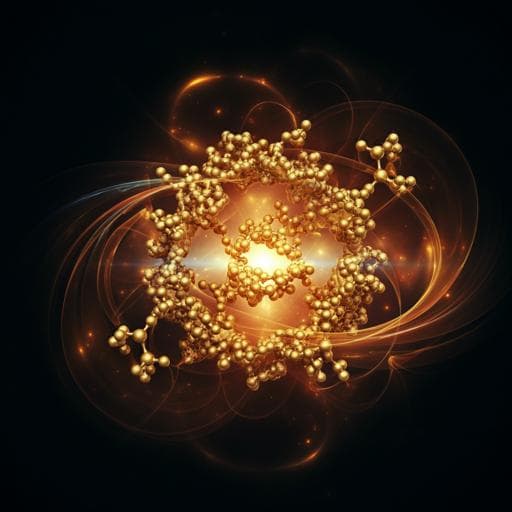
Chemistry
Ligand effect on switching the rate-determining step of water oxidation in atomically precise metal nanoclusters
Z. Liu, H. Tan, et al.
This groundbreaking study by Zhihe Liu, Hua Tan, Bo Li, Zehua Hu, De-en Jiang, Qiaofeng Yao, Lei Wang, and Jianping Xie explores how ligand engineering can dramatically enhance the kinetics of the oxygen evolution reaction in atomically precise Au25 nanoclusters. The research reveals that using para-mercaptobenzoic acid significantly boosts catalytic performance, unlocking new pathways for OER efficiency.
~3 min • Beginner • English
Introduction
Atomically precise thiolate-protected noble metal nanoclusters (NCs) with ultrasmall cores (<3 nm) exhibit molecular-like electronic properties and are promising model electrocatalysts to elucidate structure–property relationships. Electrocatalytic activity and stability depend on NC structure, including the metal core, metal–thiolate interface, and protecting ligands. While ligand effects on NC electronic structures (e.g., HOMO–LUMO gaps and adsorption characteristics) are known, their influence on the rate-determining step (RDS) of electrocatalysis has remained unclear due to difficulty in capturing key intermediates. This study investigates how ligands of similar size but different electron-withdrawing abilities (pMBA, MHA, HCys) tune the electronegativity of Au(I) sites in [Au25(SR)18] and thereby modulate OH− adsorption and OER pathways in alkaline media. The hypothesis is that stronger electron-withdrawing ligands induce greater partial positive charge on Au(I), facilitating OH adsorption, altering intermediate energetics, and switching the OER RDS.
Literature Review
Prior work established atomically precise NCs as platforms to probe catalysis at molecular/atomic levels due to discrete electronic states and quantum confinement. Tuning the metal core composition/structure can boost activity via superatomic electronic configuration changes and shifted redox potentials. Ligands, as the outermost layer, critically affect NC electronic structures through metal–ligand orbital coupling and modulate HOMO–LUMO gaps and adsorption of reactants/intermediates. However, explicit understanding of ligand-induced changes to the RDS in electrocatalysis has been lacking, motivating this study to connect ligand electron-withdrawing strength with active-site charge, intermediate coverage, and kinetic fingerprints (Tafel slopes) during OER.
Methodology
Model system: [Au25(SR)18] clusters capped with three ligands of similar molecular weight but differing electron-withdrawing ability: p-mercaptobenzoic acid (PMBA, strongest), homocysteine (HCys), and 6-mercaptohexanoic acid (MHA). Synthesis: [Au25(PMBA)18] via CO reduction by forming Au(I)–pMBA complex (pH ~11.05) followed by 7 days reaction at 25 °C; [Au25(MHA)18] and [Au25(HCys)18] via NaBH4 reduction of Au(I)–ligand complexes with NaOH adjustment; Au nanoparticles (~5 nm) via NaBH4 reduction with PMBA as a comparator. Purification: concentration, ethanol precipitation, centrifugation, DMF washing, re-dissolution in water. Characterization: UV–Vis (distinct ligand-dependent peak shifts), ESI-MS (charge states confirm [Au25(SR)18] formula), TEM (~1 nm cores), XPS (Au 4f shifts), and differential charge density maps from DFT to probe Au(I)–S electronic structure. Electrochemistry: Standard three-electrode H-type cell, Nafion 117 membrane, 1.0 M KOH electrolyte, O2-saturated (15 min). Ag/AgCl reference, Pt foil counter, carbon paper working electrode (1 cm2). Catalyst ink: NCs with Vulcan XC-72 in NMP plus 5 wt% Nafion; loading 0.026 nmol Au25 per electrode; dried at 60 °C under vacuum. LSV and CV at 5 mV s−1 with iR correction. ECSA by double-layer capacitance in non-Faradaic region. EIS Nyquist at 1.65 V vs RHE. TOF calculated leveraging atomically precise active-site counts. O2 quantification by online GC to assess Faradaic efficiency and stability tests (i–t at multiple potentials). In situ Raman: confocal Raman (532 or 488 nm excitation), 100× objective, 1800 g/mm grating; potentials swept around onset; spectral window 550–850 cm−1 to capture Au–OH and Au–O–OOH vibrations; intensity vs potential analysis. Computations: DFT with DMol3 (PBE-GGA, DNP basis, DFT-D TS dispersion, COSMO water) for differential charge density; CP2K (PBE with Grimme D3, MOLOPT-SR-DZVP basis, GTH pseudopotentials, 400 Ry cutoff) for adsorption energies and OER thermodynamics via computational hydrogen electrode. Models: [Au25(SCH3)15(SR)3] with SR = PMBA or MHA (three explicit deprotonated real ligands on one dimeric motif; others SCH3); q = 0 charge state. Adsorption sites: O and OH on Au(I) in the dimeric motif.
Key Findings
- Performance hierarchy: [Au25(PMBA)18] exhibits superior OER activity to [Au25(HCys)18] and [Au25(MHA)18] in 1.0 M KOH. To reach 10 mA/cm2, overpotentials are ~360 mV (PMBA), 470 mV (HCys), and 540 mV (MHA). Carbon paper baseline shows negligible current.
- Tafel slopes indicate RDS switching: PMBA 62 mV/dec (suggesting Au–O–OOH decomposition slower than other steps), HCys 196 mV/dec, MHA 304 mV/dec (implying deprotonation of Au–OH as RDS). Thus, ligand identity changes the RDS.
- Intrinsic activity: TOF of [Au25(PMBA)18] is nearly 4× that of HCys- and MHA-capped clusters at 1.65–1.70 V. TOF increases with Au(I)/Au(0) ratio from XPS deconvolution, correlating with ligand electron-withdrawing strength.
- Charge transfer and active-site electronic structure: XPS Au 4f shows the largest positive shift for PMBA-capped clusters; DFT differential charge density maps reveal greater charge deficiency on Au(I) adjacent to PMBA compared to HCys or MHA, indicating stronger electron withdrawal by PMBA.
- Intermediate identification by in situ Raman: For MHA and HCys, Au–OH vibrations emerge around ~600–700 cm−1 above ~1.4 V; for PMBA, an ~800 cm−1 peak (Au–O–OOH O–O vibration) grows with potential. Intermediate coverage increases with potential for all ligands.
- Kinetics and transport: EIS shows the smallest semicircle (lowest charge-transfer resistance) for PMBA-capped clusters. Double-layer capacitances are comparable (PMBA 28.85 mF/cm2; MHA 17.30; HCys 20.20), supporting that activity differences are kinetic rather than surface-area driven.
- Faradaic efficiency and stability: Oxygen evolution shows linear charge–volume relation with FE ~99.5% for PMBA at 10 mA/cm2. Stability: PMBA maintains nearly invariant current in the tested potential window (1.57–1.66 V); HCys retains ~96% after 10 h; MHA decays to ~60% after 10 h. UV–Vis/ESI-MS confirm largely preserved [Au25(SR)18] formulas post-OER, with PMBA most stable.
- Adsorption energetics (DFT): OH and O adsorption on Au(I) in the dimeric motif are less strong with PMBA than with MHA, facilitating activation and correlating with higher OER activity. Ligand electron-withdrawing strength also lowers LUMO and shifts UV–Vis peaks.
Discussion
The results demonstrate that ligand electron-withdrawing strength modulates the partial positive charge on Au(I) active sites in [Au25(SR)18], tuning OH− adsorption and the energetics of OER intermediates. Stronger electron-withdrawing PMBA increases Au(I) charge deficiency, promoting feasible OH adsorption and altering intermediate coverages. This changes the kinetic bottleneck from Au–OH deprotonation (MHA/HCys) to Au–O–OOH decomposition (PMBA), as evidenced by Tafel slopes and in situ Raman signatures. The improved kinetics (lower charge-transfer resistance, higher TOF) and near-unity Faradaic efficiency confirm that ligand engineering can switch the RDS and enhance intrinsic activity without relying on increased electrochemically active surface area. DFT findings align with experiments, showing weaker OH and O binding on PMBA-capped Au(I), consistent with easier intermediate activation. The OER mechanism on Au nanoclusters differs from bulk Au oxide pathways, underscoring the unique reactivity of atomically precise NCs and the importance of ligand-induced electronic effects.
Conclusion
This work establishes that ligands can switch the rate-determining step of the oxygen evolution reaction on atomically precise [Au25(SR)18] nanoclusters. PMBA, with the strongest electron-withdrawing ability, increases Au(I) partial positive charge, enabling favorable OH adsorption, shifting the RDS to Au–O–OOH decomposition, and delivering superior OER performance (lower overpotential, 4× higher TOF, ~99.5% FE, enhanced stability) versus HCys and MHA. Mechanistic insights from XPS, in situ Raman, and DFT link ligand-induced electronic structure changes to catalytic kinetics. These findings provide a molecular-level framework for ligand engineering to optimize active-site electronics and kinetics in metal nanocluster electrocatalysts, motivating exploration of broader ligand chemistries and cluster systems to further tailor OER pathways and performance.
Limitations
- Scope of ligands: only three ligands of similar molecular weight were examined; broader functional groups and electronic characteristics may yield different trends.
- Medium and conditions: studies were conducted in alkaline 1.0 M KOH; behavior in neutral/acidic media was not assessed.
- In situ detection limits: Raman signals for intermediates below ~1.4 V were not resolved for MHA/HCys; intermediate assignments rely on literature-reported band positions with possible size effects causing shifts.
- Stability: while [Au25(PMBA)18] shows strong stability, MHA and HCys exhibit notable current decay; minor degradation of PMBA-capped clusters is indicated by slight UV–Vis intensity loss.
- Computational simplifications: adsorption energy calculations used simplified models [Au25(SCH3)15(SR)3] to reduce cost; explicit solvent/electrode effects and full ligand shells were approximated, which may affect quantitative energetics, though qualitative trends match experiments.
Related Publications
Explore these studies to deepen your understanding of the subject.







